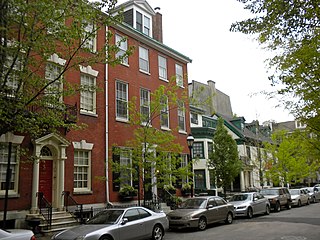
Washington Square West is a neighborhood in Center City, Philadelphia, Pennsylvania, United States. The neighborhood roughly corresponds to the area between 7th and Broad Streets and between Chestnut and South Streets, bordering on the Independence Mall tourist area directly northeast, Market East to the north, Old City and Society Hill to the East, Bella Vista directly south, Hawthorne to the southwest, and mid-town Philadelphia and Rittenhouse Square to the west. The area takes its name from Washington Square, a historic urban park in the northeastern corner of the neighborhood. In addition to being a desirable residential community, it is considered a hip, trendy neighborhood that offers a diverse array of shops, restaurants, and coffee houses. Washington Square West contains many gay-friendly establishments, especially in the gay village area of the neighborhood commonly known as the Gayborhood, which hosts annual events celebrating LGBT culture in Philadelphia, including OutFest.
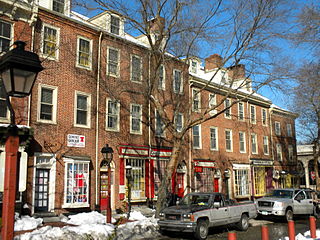
Society Hill is a historic neighborhood in Center City Philadelphia, Pennsylvania, United States, with a population of 6,215 as of the 2010 United States Census. Settled in the early 1680s, Society Hill is one of the oldest residential neighborhoods in Philadelphia. After urban decay developed between the late 19th and early 20th centuries, an urban renewal program began in the 1950s, restoring the area and its many historic buildings. Society Hill has since become one of the most expensive neighborhoods with the highest average income and second-highest real estate values in Philadelphia. Society Hill's historic colonial architecture, along with planning and restoration efforts, led the American Planning Association to designate it, in 2008, as one of the great American neighborhoods and a good example of sustainable urban living.
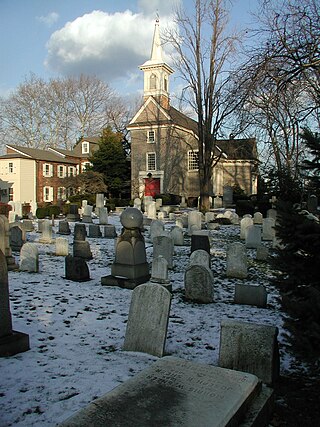
Queen Village is a residential neighborhood of Philadelphia, Pennsylvania, United States that lies along the eastern edge of the city in South Philadelphia. It shares boundaries with Society Hill to the north, Bella Vista to the west and Pennsport to the south. Street boundaries are the south side of Lombard Street to the north side of Washington Avenue, the Delaware River to 6th Street, encompassing two principal commercial corridors, South Street and Fabric Row on 4th Street.
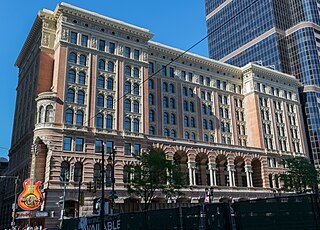
The Reading Terminal is a complex of buildings that includes the former Reading Company main station located in the Market East section of Center City in Philadelphia, Pennsylvania, United States. It comprises the Reading Terminal Headhouse, Trainshed, and Market.

Union Square is a neighborhood located in the Sowebo area of Baltimore. It dates to the 1830s and includes a historic district of houses and commerce buildings.

The University of Pennsylvania Campus Historic District is a historic district on the campus of the University of Pennsylvania, in Philadelphia, Pennsylvania, USA. The university relocated from Center City to West Philadelphia in the 1870s, and its oldest buildings date from that period. The Historic District was added to the National Register of Historic Places on December 28, 1978. Selected properties have been recorded by the Historic American Buildings Survey, as indicated in the table below.

Grumblethorpe, in Germantown, Philadelphia, Pennsylvania, was the home of the Wister family, who lived there for over 160 years. It was built in 1744 as a summer residence, but it became the family's year-round residence in 1793. It is a museum, part of the Colonial Germantown Historic District.

The George W. South Memorial Church of the Advocate, also known as the George W. South Memorial Protestant Episcopal Church, is a historic church at 18th and Diamond Street in North Philadelphia, Pennsylvania, USA.
Oscar Gregory Stonorov was a modernist architect and architectural writer, historian and archivist who emigrated to the United States from Germany in 1929. His first name is often spelled "Oskar".

The John Coltrane House is a historic house at 1511 North 33rd Street in Philadelphia, Pennsylvania, USA. A National Historic Landmark, it was the home of American saxophonist and jazz pioneer John Coltrane from 1952 until 1958. On his death in 1967 the house passed to his cousin, who sold it in 2004. Efforts for restoration and reuse as a jazz venue are struggling. In 2022, two of Coltrane's sons filed a lawsuit contesting the ownership of the home.

The Reynolds-Morris House is an historic house which is located at 225 South 8th Street in the Washington Square West neighborhood of Philadelphia, Pennsylvania. Built between 1786 and 1787 by John and William Reynolds, it is a well-preserved example of a Philadelphia Georgian townhouse.

The William Trent House is a historic building located at 15 Market Street in Trenton, Mercer County, New Jersey. It was built in 1719 for William Trent and is the oldest building in Trenton. He founded the eponymous town, which became the capital of New Jersey. It has served as the residence for three Governors. The house was added to the National Register of Historic Places and listed as a National Historic Landmark on April 15, 1970, for its significance as an example of Early Georgian Colonial architecture.

The Athenæum, originally named Das Deutsche Haus, is the most ornate and best-preserved building affiliated with the German American community of Indianapolis. Once used as a German American Turnverein and clubhouse, it currently houses many groups, organizations, and businesses. The Athenæum is located across Massachusetts Avenue from the Old National Centre. It was placed on the National Register of Historic Places on February 21, 1973. On October 31, 2016, it was named the 41st National Historic Landmark in Indiana.
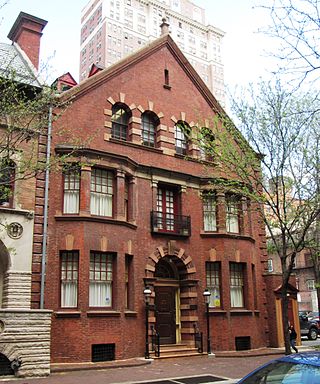
The Dr. Joseph Leidy House is a historic residence located at 1319 Locust Street between S. 13th and S. Juniper Streets in the Washington Square West neighborhood of Philadelphia, Pennsylvania. It was built in 1893-94 and was designed in the Georgian style by architect Wilson Eyre to be the home of Joseph Leidy, Jr., the nephew of Joseph Leidy (1823–1891), a noted American paleontologist with whom he is often confused. The house is next door to the Clarence B. Moore House, which was designed by Eyre in 1890. From 1925 to 1979, the Leidy House served as the clubhouse of the now-defunct Poor Richard Club, whose members worked in advertising, and with the Moore House next door, was part of the Charles Morris Price School of Advertising and Journalism. Currently, it is the headquarters of District 1199C, the National Union of Hospital and Health Care Employees.

The Hatfield House is an historic house which is located in Fairmount Park in Philadelphia, Pennsylvania.

Farmer's Southern Market is a historic farmer's market located in downtown Lancaster, Lancaster County, Pennsylvania. It was designed by noted Lancaster architect C. Emlen Urban and built in 1888. It is a brick building consisting of a three-story headhouse and two-story markethouse, in the Queen Anne style. It measures 90 feet wide and 250 feet deep. It features ornamental terra cotta and brickwork and towers. The city closed the market in the late 1980s, and has since housed Lancaster's Visitors Bureau, offices and Council Chambers.

The Nevada City Downtown Historic District is a 16-acre (6.5 ha) historic district in Nevada City within the U.S. state of California. Located in Nevada County, it was listed on the National Register of Historic Places in 1985. It dates from 1917, with examples of Moderne and Italianate architecture. The period of significance is 1856-1917. The historic district covers the downtown section roughly bounded by Spring, Bridge, Commercial, York, Washington, Coyote, and Main Streets. It includes 70 contributing buildings including the National Hotel, which is separately listed on the National Register. Several historical buildings have received California Historical Landmark status, and have been preserved.

Richardson Brognard Okie Jr. (1875-1945) was an American architect. He is noted for his Colonial-Revival houses and his sensitive restorations of historic buildings.
Friends meeting houses are places of worship for the Religious Society of Friends, or Quakers. A "meeting" is the equivalent of a church congregation, and a "meeting house" is the equivalent of a church building.























